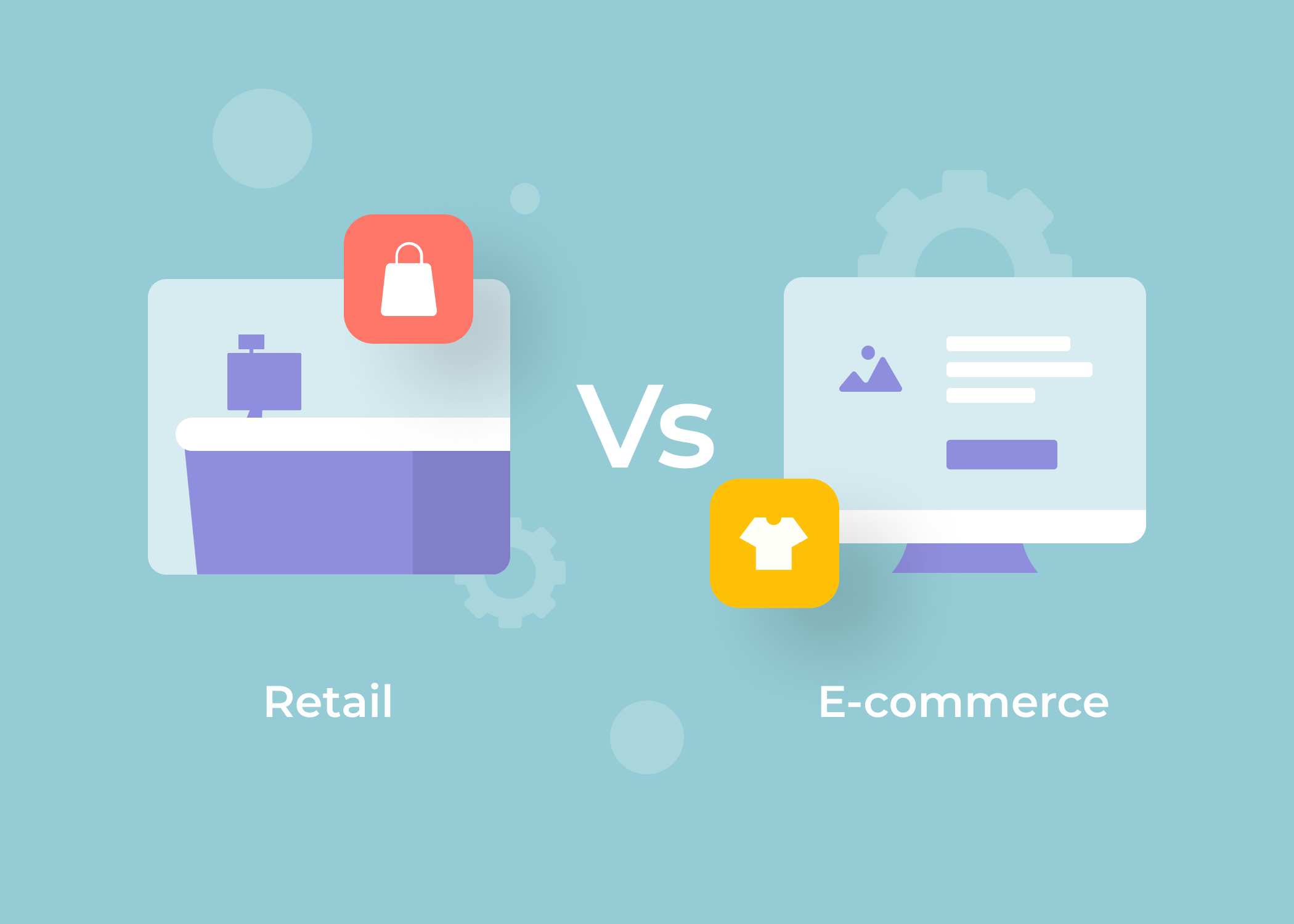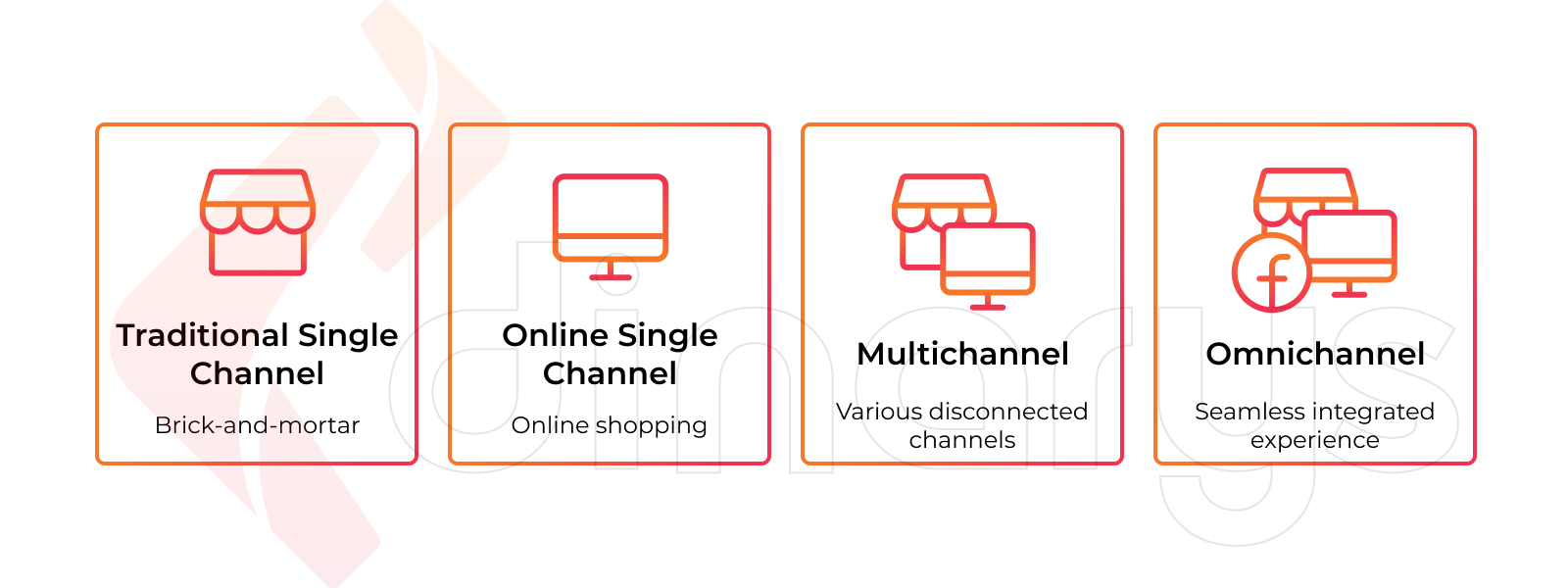Content
E-commerce vs. Retail: Understanding the Differences

Time to read: 20 minutes
When you dive into the business world, you will come across unfamiliar terms, but anyone who is involved in e-commerce, whether as a seller or a buyer, should be familiar with the terminology.
In our blog, we cover important e-commerce topics, such as the use of microservices in e-commerce, and we guide our readers through the process of building an online electronics store. In this article, we focus on an issue that seems to be superficial and obvious at first glance. What is the difference between retail and e-commerce?
Retail and e-commerce are two concepts that often go hand in hand. However, when we delve into the specifics, the differences between retail and e-commerce become clear. Take a look at our in-depth analysis of e-commerce vs. retail to understand the basics and answer the ultimate question: What is the key principle of successful retail?
What Is Retail?
Retail is the sale of products and services directly to consumers. Retailers order products in bulk from manufacturers or distributors and then sell them in smaller quantities to a single consumer at marked-up prices.
Retail integrates all types of online and brick-and-mortar touchpoints, and it is the final stage of the commercial supply chain. The retail process includes the following steps:
- Manufacturers produce goods from raw materials.
- The final products are sold to wholesalers.
- Retailers purchase the final products from either manufacturers or wholesalers at a low cost.
- Retailers sell these products to end customers for profit.
Retail vs. wholesale
Wholesale is also worth mentioning. It is a counterpart to retail, and it is the act of selling goods and services to retail stores in large quantities.
Business-to-customer (B2C) is another way to refer to retail, and business-to-business (B2B) refers to wholesale operations. The picture below illustrates the retail and wholesale processes.
s.png)
The use of each process greatly affects the customer experience. Both retailers and wholesalers want to increase their sales, but they approach their clientele in different ways. For example, in the B2C market, merchants deal with individual decision-makers and prioritize their emotional engagement. However, B2B businesses use more formalized communication since their prospects’ decision-making is driven by rationality rather than emotion.
Take a look at this article to discover other differences between B2C and B2B.
Types of retail stores
As we mentioned, retail transactions can occur both online and offline. The following list outlines the most important retail venues:
- Specialty stores. This type of retail outlet generally provides a narrow product assortment that includes only a few product lines, such as a clothing store. Examples of specialty stores in the U.S. include Home Depot and Staples.
- Department stores. These are more complex retail outlets that provide a wide variety of product lines. The most popular department stores in the U.S. are Target, Dollar Tree, etc.
- Convenience stores. These outlets are usually located in residential areas and offer a limited assortment of convenience products, such as coffee, snacks, and tobacco products, at a higher price.
- Discount stores. These stores focus on a higher volume of sales at lower margins. Target is an example of a discount store.
- Supermarkets. These retail establishments specialize in food and household products.
- Hypermarkets. Simply put, hypermarkets are large supermarkets. They are huge stores that feature a bulk display of goods. Hypermarkets may combine different specialty stores and compete with malls.
- Malls. A mall is a retail touchpoint that is predominantly located in urban areas. It is a large building with several floors that may contain specialty and department stores, supermarkets, hypermarkets, and entertainment venues, such as theaters and restaurants.
- Warehouse stores. These grocery stores sell products in bulk at lower prices than traditional supermarkets.
- E-commerce stores. Unlike the other touchpoints, e-commerce stores operate via the internet. The offers are presented on online portals that enable customers to place an order, enter their address, make an online payment, and receive their orders through delivery.

What Is E-Commerce?
In comparing e-commerce and retail, it is important to note that e-commerce can be a component of retail or wholesale businesses. E-commerce is the process of selling goods and services over the internet. In contrast to retail, e-commerce covers both B2C and B2B transactions.
Another core difference between e-commerce and retail is that retail involves the use of multiple sales channels, but e-commerce involves selling and buying exclusively through the internet. Therefore, not every retail store includes e-commerce, and not every e-commerce store includes retail.
Types of e-commerce business models
We previously highlighted B2C and B2B as the main types of e-commerce businesses. However, you should be aware of other types of e-commerce business models.
- Consumer-to-consumer (C2C). With this business model, consumers act as both sellers and buyers. Generally, C2C sales refer to the secondary market, where people sell secondhand goods. C2C physical touchpoints include flea markets, and C2C digital touchpoints include special web portals, such as OLX and Quickr.
- Consumer-to-business (C2B). This model reverses the B2C business model and encompasses the sale of goods or services from consumers to businesses. This model is widely used for crowdsourcing-based projects. An example of a C2B transaction is when a business looks for logo design services or royalty-free media.
- Business-to-administration (B2A). This business model includes online transactions that occur between businesses and administrative entities. The B2A model is commonly used for fiscal activities, legal documents, social security, employment, etc.
- Consumer-to-administration (C2A). Just like businesses, consumers may also conduct business with public administrations. For example, C2A operations may be used for education, taxes, and health.
Lets talk about itHave a project in mind?
How has e-commerce changed the future of retail?
The retail industry dates back to B.C. times and has existed for centuries. As mankind has progressed, retail has also changed significantly. The most significant change occurred with the development of informational technology. In fact, it has born a new form of trade known as e-commerce.
E-commerce has not replaced traditional shopping, but it has transformed our expectations of the shopping experience, and it comprises a bigger share of total retail sales than even a couple of years ago.

So, how does e-commerce affect our shopping habits?
M-commerce takes over
E-commerce has provided a new way for us to shop. We are now free to browse sales offers around the clock, so we no longer have to adhere to business hours. M-commerce has also impacted our lifestyle and has taken retail to the next level.
The graph below shows the growth of m-commerce sales from 2016–2021.

The rise of m-commerce is evident. Retailers now rely heavily on m-commerce sales, and there are many m-commerce marketing tactics that engage and retain buyers. In turn, buyers enjoy mobility, easy access, and fast transactions.
For instance, if customers forget their wallets at home, they can pay with their smartphones. This may seem like a phenomenon for people in the older generation, but this is the reality of the modern world. Advanced users are not surprised by the technology, and, in fact, they now take it for granted.
To learn more about the benefits of m-commerce for retail businesses, read: “What Is Mobile Commerce? Everything You Need to Know”.
Customers prefer touchpoints with a more personalized experience
A personalized shopping experience is the key to retail software development success because buyers like to feel special. According to BCG, companies with stellar personalization achieve improved marketing efficiencies and higher online sales, and they develop strong, long-lasting relationships with their target audience. These companies also boost their conversion rates from 6% to 10%. So, the stakes are high, and there is no turning back.
Various e-commerce tools have made it much easier for merchants to deliver individual offers to different customer groups. With e-commerce, merchants can gain valuable insight regarding customer behavior on their web portals and identify vulnerabilities with their marketing strategies. This allows retailers to reach the right customer at the right time.
Our new article on e-commerce merchandising explains how to build your user experience by drawing on storytelling practices and data-driven algorithms.
Lets talk about itHave a project in mind?
Choice now matters to buyers more than ever
Retailers struggle to compete in a dynamic e-commerce landscape because consumers have countless choices. Buyers expect a shopping experience that is not only personalized but also diverse and consistent. Searching for flexibility, many retailers use several touchpoints, including brick-and-mortar, e-commerce, and m-commerce.
If you have considered these opportunities, then you have probably encountered the concept of omnichannel retail, which is another definition every business owner should understand.
Let’s get into the details of omnichannel retail and figure out how to efficiently connect different touchpoints “under the same roof.”
The Seamlessness of Omnichannel Retail
The omnichannel approach ensures a personalized and consistent shopping experience across multiple sales channels and devices so customers can seamlessly switch between them and continue their shopping using another touchpoint.
The multichannel approach is separate from omnichannel marketing, although these two approaches are easily confused. The multichannel approach uses independent sales channels that are not integrated with each other. The picture below compares the single-channel, multichannel, and omnichannel approaches.

Why is it imperative for retailers to use an omnichannel approach nowadays? It allows retailers to improve customer lifetime value, increase operational efficiency, and streamline inventory turnover. For more information on the benefits of omnichannel marketing, watch this video.
How can omnichannel marketing be implemented with Magento?
Obviously, an outstanding omnichannel presence is possible only with technology. The current e-commerce market is oversaturated with numerous solutions that support omnichannel marketing. In this section, we explain why Magento is a top-notch e-commerce platform that can address your omnichannel needs.
Magento is a flexible, customizable CMS used by over 250,000 businesses worldwide. At Dinarys, we often recommend Magento to retailers who are considering the omnichannel transition because it manages multiple stores, either online or offline, from one admin panel. Magento is also mobile-friendly, and it smoothly integrates with third-party services. Here is how the Magento omnichannel retail system may look like:

Within a cost-effective omnichannel framework, Magento also offers the advantage of possibly going headless and splitting the front end and back end of your e-commerce solution to create a centralized database that is common for all touchpoints. You can learn more about headless commerce by reading this article and discover key benefits of composable commerce in this article.
Read more in our blog Top Mistakes in Ecommerce Retail to Avoid.
Conclusion
Not every retail store involves e-commerce, and not every e-commerce store involves retail. So, what is the core difference between retail and e-commerce? Retail applies to B2C sales transactions that occur through online or offline touchpoints. On the other hand, e-commerce supports all types of business models, including B2C, B2B, C2A, etc. but only through online transactions.
Fierce competition dictates new rules. The key principle of successful sales is building a retail presence that rests on the two pillars of e-commerce and omnipresence.
As an e-commerce development company, we have established, over the years, a transparent and effective development process that succeeds every time. Send us a message, and we will help your business unleash its full potential and reach every one of your customers with the use of Magento and its omnichannel capabilities.
Let professionals meet your challenge
Our certified specialists will find the most optimal solution for your business.




